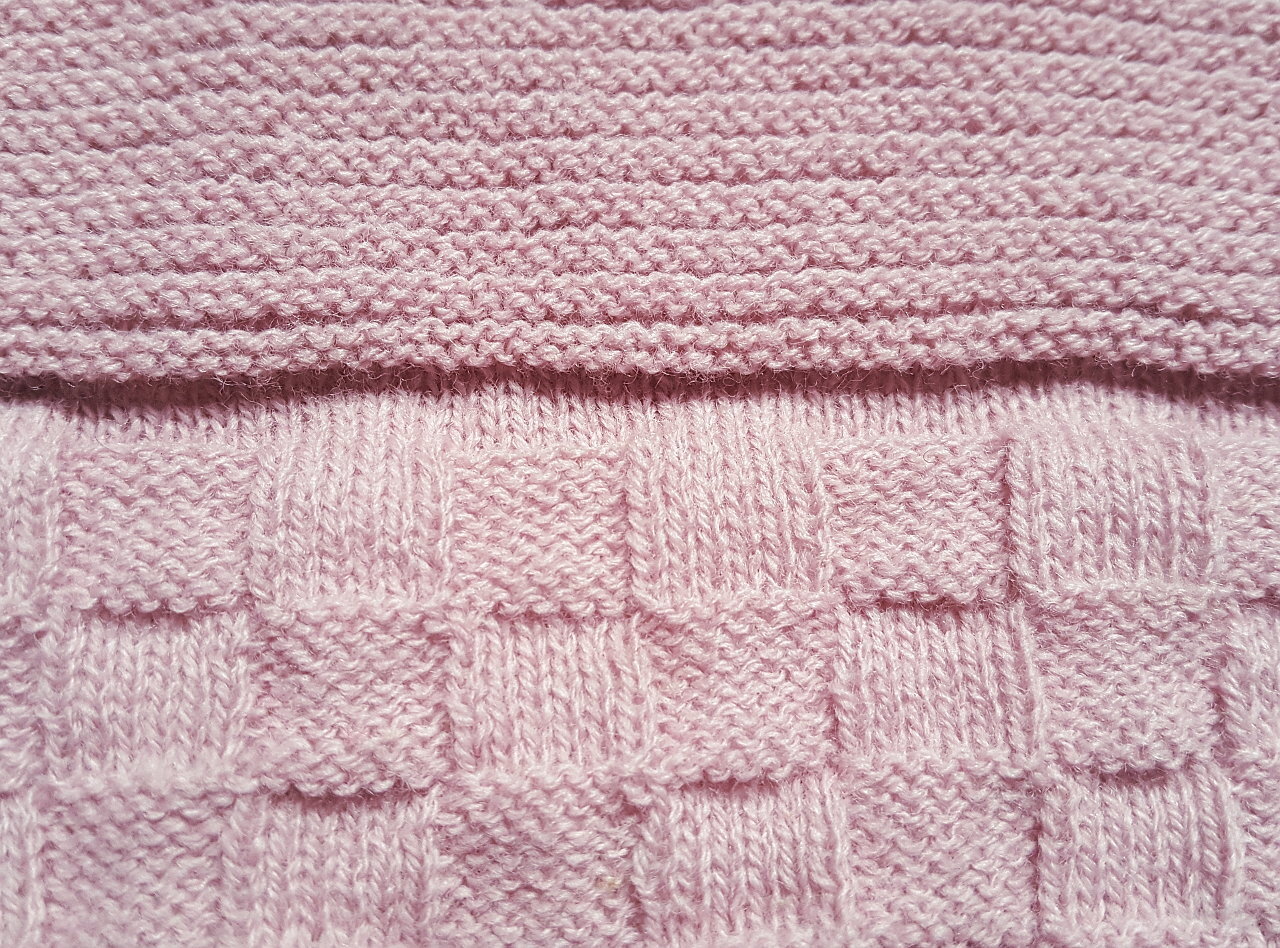Is it possible to knit garter stitch or seed stitch on a knitting machine?
“Is it possible to knit garter stitch or seed stitch on a knitting machine?” Valerie asked. “I know that you need a ribber to be able to alternate knit and purl stitches, so it seems to me that seed stitch should be possible if you had a ribber. I have also heard of a garter bar, but have no idea how it works.” Valerie goes on to describe the machine she owns, her past knitting experience many years ago, and a potential machine knitting venture.
Yes, Valerie, it's possible to knit both a garter stitch and a seed stitch on a knitting machine. The sample above with garter ridge (a garter stitch variation) on top and the basket weave (a seed stitch variation) on the bottom were both knitted on a Kniterate, but each stitch is possible on a home knitting machine with some manipulation, the use of a transfer carriage, or by using a garter carriage. In industry when both knit stitches and purl stitches occur in the same wale (column of stitches) the fabrics come under the category of purl knits or links-links. There are special industrial machines for creating this type of fabric. At one point a links-links machine was even created for the home market! @lifi68 acquired a domestic links-links machine a few years ago and posted it on Instagram. Unfortunately, the home machine is no longer manufactured.
Though it can get complex, you can knit garter and seed stitches on any knitting machine. Just as a hand knitter knits a row then turns the knitting and repeats, a garter bar helps the machine knitter perform the same task on a single bed machine. The machine knitter knits a row, then using a garter bar, turns the knitting and repeats. Sounds simple enough, but this is how a garter stitch really works with the garter bar. The knitter must:
knit a row
carefully remove the knitting from the machine needles onto the garter bar
remove the yarn from the feeder
place the needle stopper
turn the garter bar with fabric attached
carefully place the knitting back on the machine needles
free pass the carriage to the other side of the knitting
place the yarn back in the feeder
Whew! Now the knitter is ready to knit the second row. With the garter ridge stitch pattern, the turning happens after knitting two rows, rather than after every row. Or the knitter could turn the fabric every several rows for wider ridges. See the first video below under “Further Info” for a look at a garter bar in action.
Garter stitch (left) and garter ridge stitch
A transfer carriage, such as the U80, U100, or U100e for a Passap machine will make a garter stitch in a different way. The fabric is knitted on a double bed machine. Instead of turning the knitting, the stitches are knitted on one bed at a time for a garter stitch. With a pass of the transfer carriage the stitches are transferred to the opposite needle bed. The sequence is repeated. Knit a row, then transfer the stitches to the opposite needle bed. Repeat. Set up the machine to only transfer stitches on selected needles for a seed or basketstitch pattern.
A garter carriage, used on a single bed of a Brother machine, is a slower operation, but it will be pretty much hands off after setup. See the second video below. Also a garter carriage has the capability of knitting and purling in the same row with just a single needle bed. That means that seed stitch and basketweave stitch patterns are possible.
Seed stitch (left) and basketweave stitch
With machines such as the Kniterate and the industrial machines, instead of turning the knitting at the end of a row with a garter bar or forming purl stitches one-by-one as the garter carriage does, the machines make use of two needle beds and transfer operations like on the Passap, only automated. Stitch transfers to the opposite bed are pre-programmed before the knitting begins. A row is knitted. Each stitch is then automatically transferred from one needle bed to the opposite needle bed. The next row is now ready to be knitted on the second bed. Transferring stitches to the opposite bed has the same effect as turning the knitting. The next knitted row will complete the garter stitch. The stitches are then transferred back to the first bed and the sequence begins again.
Knits and purls can be knitted with the same pass of the carriage, so stitch patterns such as a seed stitch or a basketweave can be easily knitted. It all depends on stitch arrangement and the programming of transfers.
Getting back to the garter bar question, if the idea is a faster way of producing garments from your handknitting pattern, understand that using a garter bar takes a lot of time and manipulation on the part of the human knitter. Using a garter carriage also takes a lot of time, though not as much human power. Both methods are probably faster than handknitting with a comparable stitch size. My suggestion would be to use a knitting machine but use patterns that don't involve garter or seed stitches! There are many beautiful stitch patterns based on jersey (stockinette) and rib stitches that are speedier to knit on a domestic knitting machine. Or if you want to make an investment, consider a Kniterate.
As it turns out, I have little direct experience with the garter bar or carriage. I welcome comments from knitters who actually use them.
O!
Further Info
See Helen Sharp of The Knitting School set up and use the a garter bar to turn fabric in this 5-minute YouTube video.
See the setup and the garter carriage in action in this 31-minute video from Thesweaterfactory on YouTube.



